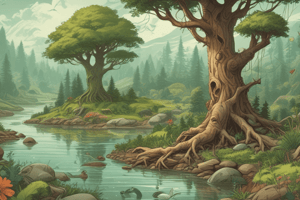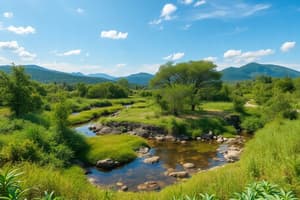Podcast
Questions and Answers
What is the primary source of energy that enters ecosystems?
What is the primary source of energy that enters ecosystems?
- Heat from the Earth's core
- Chemical reactions from decomposers
- Nutrient cycling
- Sunlight (correct)
Which of the following is NOT a level of ecological organization?
Which of the following is NOT a level of ecological organization?
- Ecosystem
- Niche (correct)
- Population
- Community
Which type of ecological relationship benefits both species involved?
Which type of ecological relationship benefits both species involved?
- Predation
- Commensalism
- Parasitism
- Mutualism (correct)
What is the term for the maximum population size an environment can sustain?
What is the term for the maximum population size an environment can sustain?
In which cycle is nitrogen converted into usable forms for plants?
In which cycle is nitrogen converted into usable forms for plants?
Which of the following is a type of consumer that exclusively feeds on plants?
Which of the following is a type of consumer that exclusively feeds on plants?
What distinguishes logistic growth from exponential growth in populations?
What distinguishes logistic growth from exponential growth in populations?
Which of the following ecological interactions involves one organism benefiting at the expense of another?
Which of the following ecological interactions involves one organism benefiting at the expense of another?
Flashcards are hidden until you start studying
Study Notes
Ecology
-
Definition: The study of interactions among organisms and their environment, encompassing both biotic (living) and abiotic (non-living) components.
-
Levels of Organization:
- Individual: A single organism.
- Population: A group of individuals of the same species living in the same area.
- Community: All the populations of different species that live and interact in a particular area.
- Ecosystem: A community of living organisms along with their physical environment.
- Biome: Large geographical biotic units characterized by distinct climate, flora, and fauna.
- Biosphere: The global sum of all ecosystems, where life exists.
-
Ecosystem Components:
- Producers: Organisms that create their own food through photosynthesis (e.g., plants).
- Consumers: Organisms that eat other organisms (divided into herbivores, carnivores, and omnivores).
- Decomposers: Organisms that break down dead material and recycle nutrients (e.g., fungi, bacteria).
-
Energy Flow:
- Energy enters ecosystems primarily through sunlight.
- Producers convert sunlight into chemical energy via photosynthesis.
- Energy flows from producers to various levels of consumers in food chains and webs.
-
Biogeochemical Cycles:
- Water Cycle: Movement of water through evaporation, condensation, precipitation, and infiltration.
- Carbon Cycle: Flow of carbon among the atmosphere, biosphere, oceans, and geosphere (involves photosynthesis and respiration).
- Nitrogen Cycle: Conversion of nitrogen in the atmosphere to usable forms by plants, and its return to the atmosphere through decomposition.
-
Ecological Relationships:
- Predation: One organism (predator) eats another (prey).
- Competition: Two or more organisms vie for the same resources (food, space, etc.).
- Mutualism: Both species benefit from the interaction (e.g., pollination).
- Commensalism: One species benefits while the other is neither helped nor harmed.
- Parasitism: One organism benefits at the expense of another.
-
Population Dynamics:
- Carrying Capacity: The maximum population size an environment can sustain.
- Growth Models:
- Exponential Growth: Population growth in an ideal, unlimited environment.
- Logistic Growth: Population growth that stabilizes as it reaches carrying capacity.
-
Biodiversity:
- The variety of life in a particular habitat or ecosystem.
- Importance includes ecosystem resilience, genetic diversity, and economic benefits.
-
Human Impact:
- Habitat destruction, pollution, climate change, and introduction of invasive species significantly affect ecosystems and biodiversity.
-
Conservation:
- Efforts aimed at protecting ecosystems and endangered species through sustainable practices and restoration projects.
Ecology
- Ecology studies the interactions between organisms and their environment, encompassing both living (biotic) and non-living (abiotic) components.
- The levels of organization in ecology are: individual, population, community, ecosystem, biome, and biosphere.
- Ecosystems consist of producers, consumers, and decomposers.
- Producers, such as plants, make their own food through photosynthesis, while consumers eat other organisms, categorized as herbivores, carnivores, or omnivores.
- Decomposers, like fungi and bacteria, break down dead material and recycle nutrients.
- Energy flows through ecosystems, entering primarily through sunlight.
- Producers capture sunlight and convert it to food through photosynthesis.
- Energy moves from producers to various levels of consumers in food chains and webs.
- Biogeochemical cycles, such as the water cycle, carbon cycle, and nitrogen cycle, involve the movement and transformation of elements within the environment.
- Predation, competition, mutualism, commensalism, and parasitism are examples of ecological relationships.
- The carrying capacity of an environment is the maximum population size it can sustain.
- Population growth models include exponential growth, which occurs in ideal, unlimited environments, and logistic growth, which stabilizes as it reaches carrying capacity.
- Biodiversity, the variety of life in a habitat or ecosystem, is crucial for ecosystem resilience, genetic diversity, and economic benefits.
- Human activities, such as habitat destruction, pollution, climate change, and the introduction of invasive species, significantly impact ecosystems and biodiversity.
- Conservation efforts focus on protecting ecosystems and endangered species through sustainable practices and restoration projects.
Studying That Suits You
Use AI to generate personalized quizzes and flashcards to suit your learning preferences.




